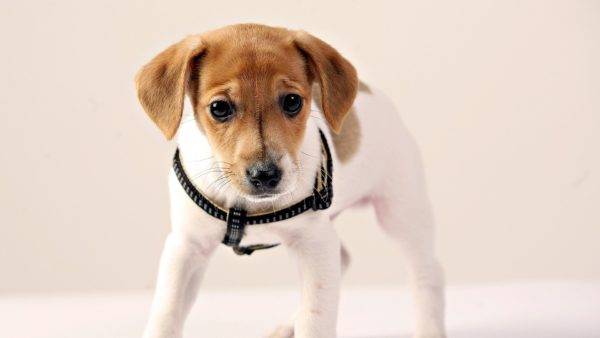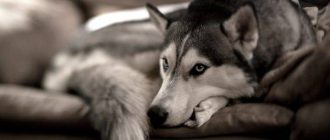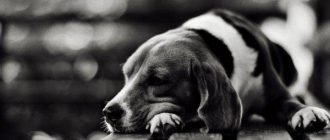Urolithiasis in dogs – a pathological condition urinary system, in which in the cavities of organs stones are formed. The crystallization of salts is accompanied by violation of diuresis, intoxication of the animal organism and inflammation urinary system.
Content
- 1. Factors of the development of pathology
- 2. Types of uroliths and their characteristics
- 3. The main signs of urolithiasis in dogs
- 4. Methods for the diagnosis of pathology
- 5. Methods of treatment of ICD
- 6. Prevention of the disease
Pathology development factors
Contents
The damaging effects of internal and external factors can provoke the development of urolithiasis (ICD) in dogs outside depending on age. However, according to statistics, 15% of animals ICD is noted, of which 70% of urolitases are diagnosed at the age of 7-8 years old, 20% – aged 4-6 years old and only 10% of dogs – aged from 1 to 3.5 years. 
There is a relationship between the incidence of urolithiasis diseases in pets with:
- Gender identity. Although the difference in results studies are small, but a little more often from urolitase suffer males, which may be due to structural features excretory system, since the length of the urethra in males is longer than in bitches, which in case of metabolic disorders facilitates loss urolytes in the urethra.
- Belonging to a particular breed. In small dogs, weight which does not exceed 10 kg, uroliths are formed due to less bladder volume, which makes emptying more rare. IN As a result, urine increases the salt content.
- Low physical activity. In dogs with which it is rare walking, or walking takes little time, the risk of education stones are significantly higher compared to active animals. Hypodynamia causes congestive processes in organs.
- Violations in the diet and consumption of water. In dogs eating foods high in mineral salts or protein, risk ICD diseases are higher than in animals on proper nutrition. Animals that drink a little liquid get sick much more often, as their urine density is increased. Dietary restriction with a large number of purines reduces the risk of disease of the dog ICD. A large amount of fiber, bran, soybeans increases the danger the formation of silicate calculi.
- Bacterial or viral infection. According to statistics, this the factor is more characteristic with the occurrence of urolitase in bitches, which also due to the structural features of the genitourinary system. At In this case, the accumulation of bacteria can become the center of crystallization of uroliths and the cause of the formation of large calculi.
Causes of stones and sand in the urinary system do not affect their composition. However, there is a dependence between the frequency of formation of uroliths of a certain nature and such factors like breed, age and gender of the dog.
Types of uroliths and their characteristics
There are 4 main types of stones formed during the ICD – struvites, urates, phosphates, oxalates. Consider their composition and groups risk in which animals of a particular breed most often fall, age and gender.
- Struvites and tripelfosphates – form ammonium salts of phosphate magnesium. Struvites are much more common in all dog breeds with diagnosed ICD. Among breeds that have a risk of formation struvites, secrete beagles, dachshunds, terriers, Pekingese. Calculus of this type can form, regardless of age, but more often total struvite urolitase affects females in the age category 3.5-5 years. The main reason for the formation of struvite stones is alkaline urine pH and the presence of pathogenic microflora.
- Oxalates – Calcium oxalates precipitate in acidic urine. Like type of calculi is characteristic of dogs of such breeds as affenpincher, shih tzu, pug, lhasa apso, lapdog, yorkshire terrier. Among Patients of a veterinarian with oxalates, mainly males aged 6-7.5 years old.
- Urate – represented by ammonium urate. Increased risk of development IBC and the formation of urate are affected by lapdogs, Dalmatians, shepherd dogs, terriers, wolfhounds. Urate is more common in dogs aged 1.0-3.5 years, and is caused by urolithiasis genetic disorders.
- Cystine is a rarely formed type of stone in bitches. Called up pathology with genetic anomalies and occurs in male dogs of the terrier, Dachshunds, Chihuahua aged 1.5-5 years.
Stones are rarely monocomponent; as a rule, they are 2 or more salt. The surface of large calculi can be smooth, nosy or covered with spikes and protrusions. According to from the predominant salt in the composition, the color may vary from white, yellowish, gray to brown. Genetic predisposition to a certain type of urate is confirmed by the fact that they are detected in representatives of certain breeds. Uroliths composed of salts of calcium phosphate or oxalate, characteristic aging dogs.
Useful: how to get rid of the smell of a dog urine.
The main signs of urolithiasis in dogs
The main sign of urolithiasis is difficulty with urinating. If urinary tract obstruction or obstruction occurs as a result of inflammation, urine may be excreted in drops or not stand out completely. The animal behaves uneasily, whining with pain. Symptoms of the pathology depend on the stage of the disease. So, eg:
- With a mild form of ICD, the following symptoms are noted: increased diuresis, traces of blood in the urine, pain and discomfort during discharge urine, the dog intensively licks the urogenital area.
- With a severe form of the disease, a constant expiration and urinary incontinence (pollakiuria), an increase in the amount of blood in the urine and increased pain (hematuria). The dog is tormented by thirst, and she drinks a lot (polydipsia), while increasing significantly (in 2-3 times) the amount of urine excreted (polyuria), which is accompanied by depressed state, weakness, apathy in the animal. because of lack of appetite can dramatically decrease weight, up to development anorexia.
- ICD stage that threatens the dog’s life: urine stops stand out completely, and this condition lasts 2-3 or more days (anuria). Dog loses consciousness as a result of cardiac failure (collapse). This manifestation of the disease may lead to the death of the animal. From the mouth of the animal smells ammonia (uremic halitosis). Vomiting may occur, which leads to severe dehydration and tonic cramps. At untimely or inadequate treatment, the condition becomes coma and can cause death.
With prolonged anuria in the animal, the bladder may burst. Chemical and mechanical irritation of the urinary tract and bacterial infection causes chronic cystitis, renal failure, pyelonephritis, nephroptosis, etc. to save the life of the pet, contact as soon as possible Veterinary clinic and undergo examination.
Methods for the diagnosis of pathology
Upon presentation of complaints and a description of the symptoms of the disease, a veterinarian conducts a visual examination and palpation of the urine the bubble. To detect, refine localization and determine the shape, the size of the stones is prescribed by radiography or ultrasound. In order to establish the type of calculus, appoint a urine test. To reveal pathological processes that accompany the ICD, analyze blood and urine salts, the number of leukocytes, bacteriosis. 
Urine for analysis should be fresh and warm. Solution cooling causes crystals to precipitate, and long-term storage distorts test results. In the presence of pathogenic microflora determine the sensitivity of microorganisms to various groups of antibiotics, to choose the most effective medicine. In case of emergency cystoscopy, cystography may be required. After clarification A doctor is developing a treatment strategy for the diagnosis.
ICD therapy methods
Treatment of urolithiasis in dogs suggests integrated approach and application of one or more methods treatment. Conservative therapy includes the following:
- Drug treatment. The animal is prescribed anti-inflammatory drugs, antibiotics, drugs that increase diuresis, painkillers and sedatives.
- The use of physiotherapy methods, such as pulsed magnetotherapy, allows to facilitate the outflow of urine, relieves inflammatory process, “crushes” some calculi, stops pain syndrome.
- Special diet and normalization of the drinking regime. On Today, many leading companies produce special feed. For example, the wet feed Urinary S / O or Urinary U / C from ROYAL CANIN. Labeling shows for prevention what types of urate intended feed. So S / O – from oxalate or struvite urolitase, and U / C – from urate and cystine calculi. For small dog, the most at risk of disease, feed created Urinary S / O Small Dog under 10 kg.
For removing stones and sand from the urinary system of a dog urinary flushing and urine output using a catheter are used. In severe renal failure, dialysis is performed – cleaning animal blood from toxins. If conservative therapy is not helps, removal of calculi is carried out by surgical methods:
- Urethrostomy – removal of calculi through the stoma – hole in urethra After restoration of patency, stoma remains not closed until the dog stabilizes.
- Cystotomy – opening of the urinary and complete removal of stones, from which cannot be eliminated by less traumatic methods.
- Retrograde urohydropropulsion – an operation in which stones, clogged urethral cavity, pushed into the bladder.
During the rehabilitation period, supportive treatment is carried out. FROM with the help of droppers, the volume of liquid is filled, introduced anti-inflammatory drugs. Recovery process controlled by dynamic studies of urine and blood. After treatment or to prevent genitourinary disease in dogs is the prevention of pathology.
Disease Prevention
In order to avoid the risk of relapse of the disease or for disease prevention in risk groups, it is necessary to exclude factors causing metabolic disorders:
- Normalize nutrition. Use high percent feed moisture (70-80%), low in phosphorus, sodium, calcium, protein. Premium and super premium foods include substances maintaining normal urine pH and promoting dissolution some types of calculi. Diet is applied for life as after conservative and after surgical treatment.
- Provide access to clean, soft (filtered) water. IN a hot period of time to drink a dog while walking.
- Do not overfeed the animal – obesity promotes education stones.
- When feeding dry food, the bowl should be in abundant clean water.
- The animal must be provided with adequate physical activity – games, walks.
- Examine the animal in time and sanitize all foci of infection, treat pathological abnormalities and ailments.
ICD prophylaxis and proper treatment will ensure the animal healthy long life.






